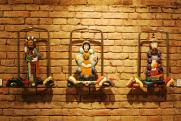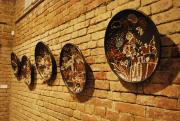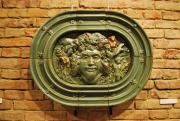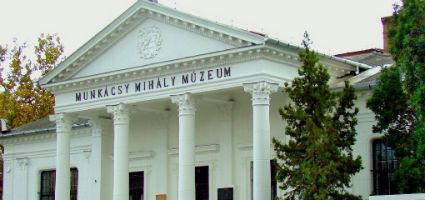 |
Address: 5600, Békéscsaba Széchenyi u. 9.
Phone number: (66) 323-377, (66) 328-040
E-mail: mmm@bmmi.hu
Opening hours: Tue-Sun 10-18
|
|
Individual ticket for adults
(valid for the permanent exhibitions)
|
800 HUF
|
/ capita
|
|
Individual ticket for adults
(valid for the 1 temporal exhibition)
|
400 HUF
|
/ capita
|
|
Individual ticket for adults
(valid for 2 temporal exhibitions)
|
600 HUF
|
/ capita
|
|
Individual ticket for adults
(valid for the permanent exhibitions + 2 temporal exhibitions)
|
1000 HUF
|
/ capita
|
|
Individual ticket for adults
|
400 HUF
|
/ capita
|
|
Individual ticket for adults
|
200 HUF
|
/ capita
|
|
Individual ticket for adults
|
300 HUF
|
/ capita
|
|
Individual ticket for adults
|
500 HUF
|
/ capita
|
|
Group ticket for adults
(valid for the permanent exhibitions, over 10 people)
|
500 HUF
|
/ capita
|
|
Individual ticket for students
(under 26 years of age, valid for the permanent exhibitions)
|
400 HUF
|
/ capita
|
|
Individual ticket for students
(under 26 years of age, valid for the 1 temporal exhibition)
|
200 HUF
|
/ capita
|
|
Individual ticket for students
(under 26 years of age, valid for 2 temporal exhibitions)
|
300 HUF
|
/ capita
|
|
Individual ticket for students
(under 26 years of age, valid for the permanent exhibitions + 2 temporal exhibitions)
|
500 HUF
|
/ capita
|
|
Group ticket for students
(valid for the permanent exhibitions, over 10 people)
|
350 HUF
|
/ capita
|
|
Individual ticket for pensioners
(valid for the permanent exhibitions)
|
400 HUF
|
/ capita
|
|
Individual ticket for pensioners
(valid for the 1 temporal exhibition)
|
200 HUF
|
/ capita
|
|
Individual ticket for pensioners
(valid for 2 temporal exhibitions)
|
300 HUF
|
/ capita
|
|
Individual ticket for pensioners
(valid for the permanent exhibitions + 2 temporal exhibitions)
|
500 HUF
|
/ capita
|
|
Ticket for families
(valid for the 1 temporal exhibition)
|
800 HUF
|
/ family
|
|
Ticket for families
(valid for 2 temporal exhibitions)
|
1000 HUF
|
/ family
|
|
Ticket for families
(valid for the permanent exhibitions + 2 temporal exhibitions)
|
2000 HUF
|
/ family
|
|
Individual ticket for families
(valid for the permanent exhibitions)
|
1500 HUF
|
/ family
|
|
Group guide
(valid for all exhibitions, up to 25 people, on prior notice, over the ticket )
|
1000 HUF
|
/ group
|
|
Group guide
(valid for all exhibitions, over 25 people, on prior notice, over the ticket )
|
100 HUF
|
/ capita
|
|
Group guide
(valid for all exhibitions, up to 25 people, on prior notice, over the ticket )
|
5000 HUF
|
/ group
|
|
Group guide
(valid for all exhibitions, up to 25 people, on prior notice, over the ticket )
|
200 HUF
|
/ capita
|
|
Group guide for adults
(valid for 3 permanent exhibition: "Pro Natura" + "Munkácsy memorial room" + "Archeological Exhibition" or "Affluence - Ethnography Exhibition", up to 25 people, on prior notice)
|
3000 HUF
|
/ group
|
|
Group guide for adults
(valid for 3 permanent exhibition: "Pro Natura" + "Munkácsy memorial room" + "Archeological Exhibition" or "Affluence - Ethnography Exhibition", over 25 people, on prior notice)
|
150 HUF
|
/ capita
|
|
Audio guide
|
100 HUF
|
/ capita
|
Győző Takács (23 June, 1938 Szeged) was a ceramic artist, designer and teacher. His works are influenced by folk art and his architectural studies. The chief profile of his work is the wide scale application of ceramics. He also does pen drawings, graphics and illustrations. Humour, grotesque spirit characterize his frescoes and reliefs.
In Budapest, he studied with Jenő Barcsay, Győző Sikota and Lelkes István at the Derkovits Visual Art Circle. At the Teacher Training Collage in Szegedi his mentors were ErnőFischer and László Vinkler. He graduated from collage in 1961. He taught in Makó for 15 years and participated in the work of the artist colony of Tokaj. He led a specialized study group and organized the Marosmente Art Colony. He moved to Békéscsaba in 1975. He was a secretary for the National Graphic Art Colony in 1976-77. He first encountered ceramics at the Majolica Factory in Vásárhely. He designed ceramics from the Mezőtúr Potter Cooperative, the Hollóháza Porcelain Factory, the Alföld Porcelain Factory, and the Switzerland based Kuntner Ceramics. . Győző Takács also worked at enamel plants in Sikós, Kecskemét and also at Yugoslavian artist colonies (Backa Topola, Zrenjanin). Today he works in Mezőtúr and actively participates in the artistic scene of the city.
He is member of the Art Found, the MAOE then, the Kohán Workshop, the Independent Hungarian Salon, the Kőrösök Regions of the Artist Association for the International Workshop Symposium Committee, the Association of Hungarian Fine and Applied Artists Art Fund. His works are there in many domestic and foreign museums, public institutions, private collections, and can be seen in public buildings in town squares as well. His work has been recognized both in Hungary and abroad with high honours .
„Győző Takács's oeuvre extremely complex, but it is also diverse. A kind of duality can be traced throughout his life work, as we can also observe in his titles: artist and ceramist, we already have launched a polyphony. Graphics (drawings, illustrations) and ceramics. Organic and classic. However, his compositions also reveal similarity, since his style is unified, however it always adapts to the form, as he does not necessarily create a broad range of items, but basically created many works so far. His tondos, plaques, busts have become clear in terms of expression, they are also transparent. His wall paintings, wells are typically more ramping, in which he kind of breaks into fertility as a kind of paradise blaming it all on nature .
In the choice of his colours the same polarisations noticeable. He either imitates metals and so is properly restrained, or particularly compelling and loud. His drawings are either detailed - although there is little free space left - or saturated with rich details or solves the task with some of playful line of forming a complete picture by their help.
Still, this art directing various ways comes from the same source as the main inspiration for Győző Takács is Hungarian folk tradition. In his works of patriotic emotions the viewer will discover important symbols and figures of Hungarian culture, may that be the the "Millennium Orb cup" expressed in ceramic or the graphics he did in "memory of Béla Kondor". he himself provides a review of illustrious Hungarian art mementos highlighting the value in terms of time, like the aforementioned examples spanning centuries; or the his geographically also linked searches for memory, leaving traces as he once visited and worked in Szeged, Pécs, Sopron, Hollóháza or Békéscsaba. He worked in public institutions, factories and artists' colonies, writing his name in the history of the town: Hic fui, that is, I was here.„
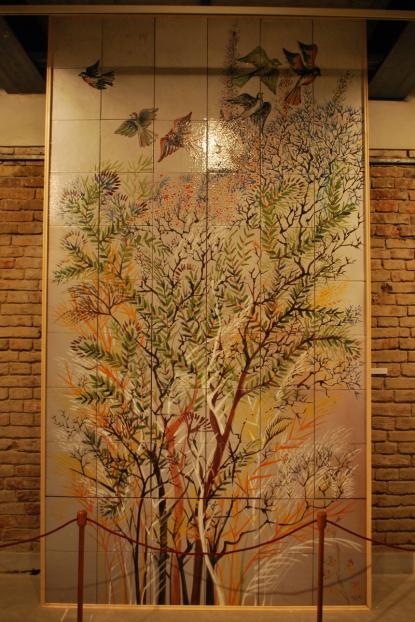 (The curator of the exhibition, Hajnalka Ván)
(The curator of the exhibition, Hajnalka Ván)

